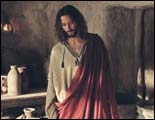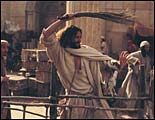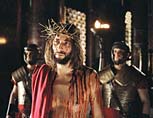In This Episode << SLIDE LEFT TO SEE ADDITIONAL SEGMENTS
Film Review: THE GOSPEL OF JOHN
THE GREATEST STORY NEVER TOLD
by Allen Dwight Callahan
THE GOSPEL OF JOHN is a movie about Jesus. In movies about biblical figures we have come to expect certain stock props, and in this one we get them. Lots of olives and pita bread, earth-tone wardrobes and earthenware, walking sticks and sandals and bearded men wrapped in what look like burlap sacks. Mises-en-scene and characters with the stylized gestures in the schmaltzy devotional paintings that adorn all those deluxe family Bibles. A sound track with reed flutes playing a lot of minor chords, and spooky music when something supernatural happens.

And there are the other clichés peculiar to Jesus flicks. The film opens down by the riverside with John the Baptist publicly raving about how he must be superseded by someone else. He gives the impression of being off his meds — and that impression is unfortunate. John the Baptist is one of the most charismatic and influential figures in the history of religion. The Jewish historian Josephus, the Roman patrician Tacitus, and the provincial Roman governor Pliny all knew of his reputation and say more about him than about Jesus. The Mandaeans, who reject Judaism, Christianity, and Islam, claim John as their patron saint and still immerse their members in flowing water in a ritual practice they trace back to him. But in European painting, which informs so much of what we see in films about the Bible, John is the stern, ascetic antithesis of the serene, superior Jesus.
The movies tend to exaggerate this contrast as they do everything else, and this one is no exception. The cost of this exaggeration is John the Baptist’s credibility. Seeing him on the screen — wide-eyed, bedraggled locks beginning to dread, affect inspired by crystal meth, attire inspired by Fred Flintstone — one is left to wonder who on earth would have run out into the desert to see this demented, hyperventilating loser.
That Jesus’ overpowering charisma eclipses John the Baptist is consonant with the New Testament claims of Jesus’ superiority, but the markers that signify this superiority in the movie make Jesus at least as unappealing as the crazed Baptist. The Jesus of the film is a suave, thirtysomething bachelor with a telegenic smile and a shoulder-length mane of blow-dried hair that is always just so — even when he is walking through a violent squall on Lake Tiberias. He refers to his disciples as his “children,” a term of endearment in the Gospel of John but hardly endearing in the mouth of this smug yuppie.

During Jesus’ extended visit to the Jerusalem Temple in wintertime, he makes several grandiose claims about himself. But in the mouth of the film’s star, these claims, spoken in the da Vinci-type faux perspective of the painted backdrop, make Jesus sound like a megalomaniac messiah stuck on himself. He struts through the streets of Jerusalem smirking at the stupidity of friend and foe alike. He is, after all, the Son of God. And he knows everything — especially how charming he is.
The producers have invested prodigious effort, however, in doing away with one of the worst clichés of Jesus movies — anti-Semitism. Jesus’ polemic against the Jerusalem elites and “the Jews” is more caustic in John than in any of the other gospels. But the movie avoids anti-Semitic stereotypes in a story notorious for them. Jesus, with his dark hair and dark eyes, is far from Max von Sydow’s Aryan icon in THE GREATEST STORY EVER TOLD. His disciples and followers do not appear to be a gang of WASPs miraculously transplanted in Palestine. And when Jesus glimpses one of his first disciples, Nathaniel, under a fig tree, Nathaniel is draped in a prayer shawl, wearing a yarmulke, and wrapping a phylactery around his arm.
We get the point. Having dodged the bullet of anti-Semitism, however, the film exhausts its will to political correctness. The high priest’s slave, Malchus, is a black man. American films about the ancient world have always cast black people as slaves: they are the fan-wavers, litter-bearers, food servers, cooks, and bottle-washers. In this film Malchus is one of two black people with a speaking part — a groaning part, actually; he cries out in pain when his ear is hacked off in the Garden of Gethsemane. The other black actor is the slave’s relative. There are one or two black extras who pop up in crowd scenes, and they too are men. In this movie black people are seen and not heard, or seen and heard as slaves, or, if women, not seen at all. I thought after Denzel Washington and Halle Berry picked up their respective Oscars we were beyond this sort of typecasting in contemporary film. I was wrong.

Understated but no less ugly are the film’s class and ethnic biases. Jesus and all the powerful people in the film speak with an upper-class British accent. Jesus comes off as the Son of God slumming in Cana and Capernaum with the Galilean bumpkins who flock to him — this in contrast to the lower-class British accents (and Irish brogues) of the common people. The film’s subtle bigotry may register only subliminally in the United States, where we still associate an upper-class British accent with intelligence and sophistication, though for the most part unconsciously. I wonder, though, how this will play in Bristol — or Belfast.
One of the most important of the important upper-class voices in the film — nagging and incessant — is that of the narrator. Narration is especially heavy-handed in the Gospel of John: the narrator makes parenthetical comments and offers explanations and even interpretations of events. Lamentably, the film translates the biblical narration into the relentless, intrusive drone of a late middle-aged, upper-class British male voice. Reading the text verbatim, he sometimes actually winds up telling us what we are seeing — a basic no-no in movie making. What is necessary in the text becomes superfluous, and worse, redundant in the film.
This is especially unfortunate because in the Gospel of John, the narrator talks a lot. And Jesus talks even more. The sheer weight of Johannine verbiage bodes ill for film, which has become such an impatient, thrill-a-minute medium. Chapters 13 through 17 of the gospel, which biblical scholars call the Farewell Discourses, are almost entirely comprised of the words of Jesus: in five chapters, the disciples barely manage to get a few words in edgewise. But here the producers exercise some cinematic creativity. As Jesus speaks to the disciples of the persecution that they will suffer in the world after his departure, we see sepia flashbacks of Jesus facing angry crowds in the first half of the film. Though they are only tinted reruns, these sharpen the point that the disciples of Jesus will suffer in the future what Jesus has suffered in the past. And as Jesus speaks of the “prince of this world,” we catch an early full-color glimpse of Pontius Pilate. All the while the locale changes as Jesus walks and talks with his disciples, having gotten up from the table and commanded them to come with him. The change of venue and image helps us to survive Jesus’ garrulousness and saves the monologue from becoming cinematic Sominex.

The screenplay also breaks with the biblical text to bowdlerize some of the gospel’s potentially disturbing details. At the wedding in Cana where Jesus performs his first miracle of changing water to wine, the film dialogue has him respond to his mother’s request that he do something for the distressed host: “Madame, what do you have to do with this?” And of course, he says it with a smile. But in the gospel, the literal rejoinder comes off more gruffly: “Woman, what is it between you and me?” This sounds as though Jesus is telling his mother to get off his back, and given that all the gospels bear witness to some tension between Jesus and the members of his immediate family, including his mother, there is good reason to so interpret his words here. But the screenplay has rendered a more delicate, less faithful translation of them.
The producers were also judiciously inconsistent in their translation of Jesus’ actions. In the movie, “the disciple whom Jesus loved” does not lay his head on Jesus’ chest, as the Bible literally describes his intimate closeness to Jesus. This would look even more homoerotic than it sounds, and so the dubious gesture, though important in the text, does not appear in the film.
There are other moments in the film that almost suggest the erotic. But those erotic moments — if I haven’t merely imagined them — are all unconscious and unintentional. Jesus stands down a murderous crowd to save the woman taken in adultery; he speaks to her in hushed tones after the mob has dispersed. The two are alone, face to face, almost nose to nose, as Jesus whispers to her, “Go and sin no more.” His sultry smile and her parted lips don’t match the dialogue, and for a few seconds the woman looks as though she is about to steal a kiss — or have one stolen from her by the sweet-talking Messiah. And then there is Mary Magdalene, who makes an early, unannounced but unmistakable entrance in a fetching orange number. She looks longingly at Jesus throughout the movie, and even makes the A list for the Last Supper. But the Jesus-Mary Magdalene dyad, fleshed out, so to speak, in JESUS CHRIST SUPERSTAR, JESUS OF MONTREAL, and THE LAST TEMPTATION OF CHRIST, remains less than a suggestion. Overjoyed to see the risen Jesus near his empty tomb, overcome by the sudden recognition that he is alive, Mary Magdalene reaches out to him — with a handshake. After surviving death, hell, and the grave, a handshake. Where is the love?

Though the film serves up dollops of melodrama — tears, grateful people falling on their knees, slack-jawed onlookers overawed by Jesus’ miracles and bons mots — there is little passion. The combination of Hollywood cinematography and relentless narration never lets us forget that we are watching a movie. We are not drawn into the drama; we already know, in the worst way, how everything is going to turn out. The Jerusalem leaders are the Bad Guys: they wear black hats. We are not invited to consider the tenuous political situation in which they found themselves. There is no need to dwell on the misery of the common people, desperately looking for a savior; whatever is wrong with them will be fixed by the Hero. They follow him in large but orderly crowds: none of the shoving, ill-mannered throngs we see in Pasolini’s THE GOSPEL ACCORDING TO SAINT MATTHEW. And as his verbal smackdowns and unflappable self-assurance make clear, Jesus has no need of our sympathy. He weeps two tears at Lazarus’s tomb — count them, one, two. He has a brief pang of anxiety after the Last Supper: “Now is my heart troubled,” he says, clutching his chest. Is it fear? A failure of nerve? Or just reflux? No matter; it passes as quickly as it came, and the drama moves inexorably to Jesus’ betrayal, his arrest, etc., etc. We see a Roman soldier energetically flogging him, although Jesus himself is off camera and takes the blows without as much as a murmur. Even when he is on the cross, Jesus sees to the welfare of his mother and yields to death with little ado. He is not even breathing hard. In his postresurrection appearances, his wounds are small, neat, and already healing quite nicely.
This absence of passion points to the greatest challenge of bringing Jesus to the silver screen: theology. The easygoing, otherworldly Jesus is a figment of the modern theological imagination. John’s is the cool, calm, collected Jesus who knows everything and has everybody all figured out. Even biblical scholars, who should know better, read the story this way: Jesus is “God astride the earth,” gushed one German scholar. But the same narrative tells us of a messiah who, with all his power and prescience, gets tired, hungry, angry, lonely, even anxious. The report of his grief at the tomb of his friend Lazarus — “Jesus wept” — is one of the most poignant sentences in all of world literature. As the gospel writer has crafted it, the scene at Lazarus’s tomb is an emotional vortex of love and death, and at its center is Jesus.

According to the Gospel of John, Jesus begins his ministry in Jerusalem with violent emotion. Yelling and spewing threats, he overturns tables, throws money, and chases sacrificial animals out of the temple court. Pious Bible editors and Sunday school teachers for centuries have traditionally entitled this episode “the cleansing of the temple.” But calling this tantrum a rite of purification is like calling Mike Tyson a massage therapist. John puts this event, reported in all four gospels, at the beginning of Jesus’ ministry, not the end as do the other three. And according to John’s version, Jesus is armed as well as dangerous: he makes a whip and then proceeds to use it to run both people and animals out of the temple. No wonder he is later accused of having a demon: the Jesus of John’s gospel, for all his self-possession, sometimes acts like a man possessed. He is an emotional Jesus, a passionate Jesus, a Jesus who, in the words of novelist David Bradley, “gets fed up.” The temple ruckus scene is one of the highlights of the movie. True to the biblical script, Jesus goes berserk. But then it’s over, and the smug, supercilious Jesus returns and is with us until the credits roll.
Even if it is “the greatest story ever told,” this film does not tell us what is so great about it. For all its fidelity to the biblical text, THE GOSPEL OF JOHN leaves out the very dimensions of the story that make for such compelling reading: its tension, its irony, its danger and pathos. We come away from the film with no better understanding of what is at stake and why someone would tell this story in the first place.
It is the same story in so many Jesus films.
I’ve read the book. I’ve seen the movie. The book is better.
Allen Dwight Callahan is a biblical scholar and the author of the forthcoming book THE SPIRITUAL GOSPEL.






